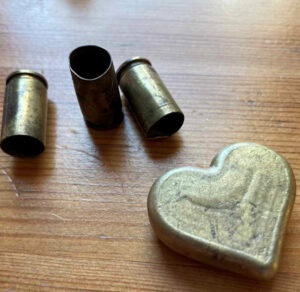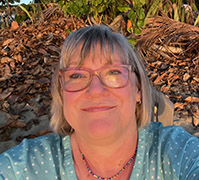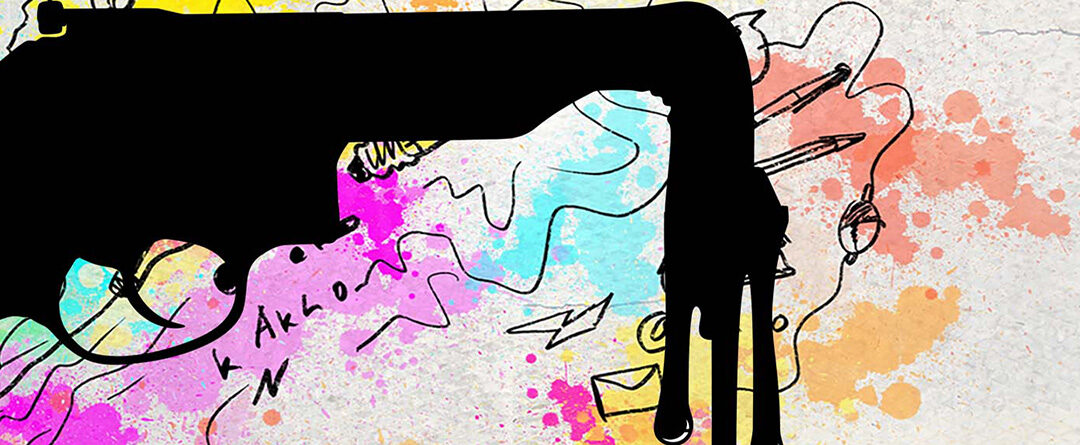by Susan Schneider
The best art enriches our lives, promotes growth, and creates an emotional response in its creation and reception. Sometimes the strong feelings art awakens in us lead us to pause and reflect; sometimes, they spur us to action. Along with protest songs and speeches, the use of visual art to inspire is widespread and varied—from the 35’ tall Black Lives Matter mural painted on the streets of Washington DC to a crayon rainbow on poster board carried in a local demonstration. Protest art is an accessible and effective way to spread messages of hope, empowerment, and urgency.
Back in 2007, creative activist and artist Pedro Reyes began a project called Palas por Pistolas in Culiacán, Mexico, a city with one of the highest rates of gun deaths in the nation. Reyes’ art installation began by inviting residents to hand over their guns. In exchange, they received a coupon to buy electronics or household appliances.
Reyes collected 1,527 weapons—40% of which were high-power automatic military-grade weapons. The next step was a dynamic public event at a military base. Everyone was invited to witness these guns being crushed flat by a steamroller. The metal fragments were then taken to a foundry, where they were melted and made into 1,527 shovel heads mounted on wooden handles. The shovels were used to plant 1,527 trees, starting in the city parks of Culiacan, and then sent to schools and art galleries around the world.
This art project—transforming violent weapons into useful objects—is a literal response to the prophet Isaiah’s call to end violence:
“The Lord shall judge between the nations, and shall arbitrate for many peoples; they shall beat their swords into ploughshares, and their spears into pruning-hooks; nation shall not lift up sword against nation, neither shall they learn war any more.” (Isaiah 2:4)
Palas por Pistolas, Jardín Botánico de Culiacán, 2008
In Palas por Pistolas, the artist demonstrated “how an agent of death can become an agent of life,” he told students at Northwestern University. The artist added, “The hope was that the transformation was not only physical but psychological and social.”
Reyes continued artistic protest with his Imagine (2012) and Disarm (2013) exhibits. This time, his work featured musical instruments—from percussion to strings to wind—that Reyes fabricated in collaboration with six musicians. The instruments were made out of 6,700 destroyed weapons collected from Ciudad Juarez, Mexico. Reyes reflects that “It’s important to consider that many lives were taken with these weapons; as if a sort of exorcism was taking place, the music expelled the demons they held, as well as being a requiem for lives lost”.
 In this country, a co-op called RAWTools embraces a similar mission with a distinctly spiritual approach that doesn’t stop with the creative process. Their mission statement explains, “It’s not enough to just make tools from guns. We need to help teach each other new ways to solve our problems through relationship, dialogue, and alternative means of justice”.
In this country, a co-op called RAWTools embraces a similar mission with a distinctly spiritual approach that doesn’t stop with the creative process. Their mission statement explains, “It’s not enough to just make tools from guns. We need to help teach each other new ways to solve our problems through relationship, dialogue, and alternative means of justice”.
Mike Martin, Founder and Executive Director of RAWTools is a former Youth and Young Adult Minister who felt compelled to take action following the slaughter at Sandy Hook Elementary School in 2012, particularly because his wife is a teacher. Martin asked a blacksmith friend to teach him how to melt metal and reshape it. Empowered by the activity and recognizing it would be relatively easy for novices, Martin found ways to involve others in the literal interpretation of Isaiah’s text. More than just something lovely emerging from something deadly (like brass hearts made from bullet casings), what Martin finds transformative are the stories shared in the process (Personal Interview, May 11, 2023).
RAWtools implements protest art into a comprehensive strategy for wholeness and healing, hosting workshops for converting weapons into garden tools and symbolic art (like this brass heart made from bullet casings) but also sponsoring nonviolence trainings and healing dialogues and providing resources to people seeking to overcome trauma caused by violence.
Made in the image of a creative God, it is not surprising that humans are drawn to creating. Nor is it remarkable that our imaginations and souls are captured by the beauty of other people’s artistry, for—as the Psalmist reminds us—“deep calls to deep” (Psalm 42:7). From the very beginning, Christians relied on artistic renderings of Biblical stories and theological concepts to teach their often illiterate communities about God. These paintings, drawing, stained glass windows, sculptures, etc., shaped and molded the faith of those who fashioned or studied them. However, while it can be tempting to relegate art to the category of passively appreciating beauty, it also can be an accessible and effective way to mobilize God’s people to live into our Baptismal calling to “work for justice and peace in all the world.”
The God in whose image we are made is a God who stands solidly among people who are suffering, excluded, or marginalized, so while creativity needs to soothe and comfort, it also needs to stir up resistance and transformation—what the late Congressman John Lewis called “good trouble.” So, Jesus-followers, grab your sidewalk chalk or your stained glass, your anvil, or your construction paper: it’s time to change the world.
Discussion questions:
1. Besides gun violence, what issues can be addressed through art?
2. When has art provoked you? How did you respond?
4. What does it mean to be created in the image of a God who actively grants people both consolation and uneasiness?
Closing prayer:
Dearest Jesus, you calmed the storm and raised the dead, played with children and challenged authorities. Stir up in us the courage to pursue justice and the gentleness to rest quietly in you. Let both be artistic reflections of you. Amen.
 Pastor Sue Schneider was born and grew up in the Philippines, the middle child of Lutheran Church-Missouri Synod missionaries. Her first career was teaching English on the middle, high school, and college levels. She graduated from Pacific Lutheran Theological Seminary in 2002, and has served as a pastor in Iowa, Illinois, Wisconsin, and Washington; now she is Interim Associate Pastor at Messiah Lutheran Church in Cypress, TX. Sue is passionate about appreciating and making art–especially stained glass mosaics.
Pastor Sue Schneider was born and grew up in the Philippines, the middle child of Lutheran Church-Missouri Synod missionaries. Her first career was teaching English on the middle, high school, and college levels. She graduated from Pacific Lutheran Theological Seminary in 2002, and has served as a pastor in Iowa, Illinois, Wisconsin, and Washington; now she is Interim Associate Pastor at Messiah Lutheran Church in Cypress, TX. Sue is passionate about appreciating and making art–especially stained glass mosaics.


I just love the Gatherings and all the love and support of my sisters near and far. I try to never miss a gathering. It has become apart of me. Love you all. Nancy Jan Dorr. Trinity Luthrean St. Petersburg Fla